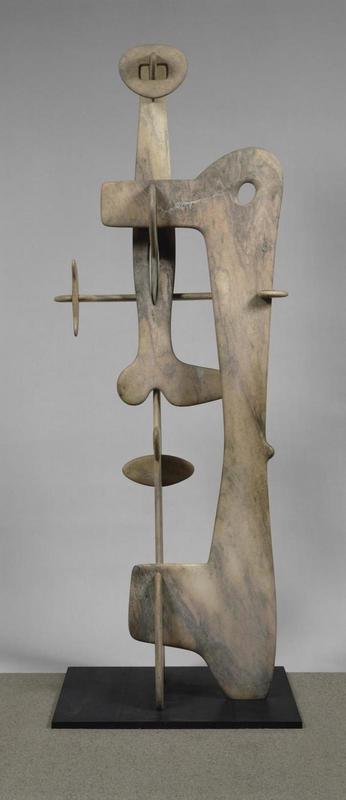More about Kouros

Sr. Contributor
They say never to meet your idols, but Isamu Noguchi really made the most out of meeting his.
A university professor and sculptor, Noguchi’s deep knowledge of art influenced his approach to artmaking. When presented with the opportunity, Noguchi understandably jumped at the chance to study with Constantin Brâncuși in Paris. Brancusi profoundly impacted the way Noguchi learned to handle stone. Noguchi also worked with Alexander Calder and assisted him in the creation of his infamous wire circus.
Noguchi didn’t only look to his contemporaries for inspiration, though. He maintained a broad view of art history and derived inspiration from various time periods and styles. Kouros draws from a type of ancient Greek statue from the Archaic period. A Greek kouros is a sculpture of a lone, male figure that often appears mid-stride. Despite the traditional roots of this sculpture, Noguchi was by no means married to these traditions. He was a modern sculptor who pushed the boundaries of what the medium could accomplish. While the Greek original would have been carved from a block of stone, Noguchi carved eight pieces of stone and fit them together like a puzzle. It’s as much a lesson in physics and engineering as it is an experience of fine art. With interlocking notches, pins carved from the same marble, and a bit of beeswax, the pieces work with the weight of the stone to hold themselves together.
Kouros creates a perfectly precarious situation that hints at Noguchi’s worldview. Being an American with Japanese ancestry, Noguchi viewed World War II differently than other Americans. But he also viewed it differently than the Japanese. To try to understand the experience of Japanese in the United States, Noguchi went so far as to join a Japanese internment camp in Arizona. As a United States citizen who volunteered himself for internment, Noguchi had some additional privileges at the camp, but he saw how difficult life had become for those who had been labeled as “other.” Like the Abstract Expressionists who painted their feelings, Noguchi also took to his art. Many of Noguchi’s works meditate on existential feelings. After World War II, these questions stayed with Noguchi, and he used his art to ponder his place in it all.
In the 1950s, Noguchi began the first of many trips to Greece, continuing to visit the country for nearly forty more years. While he sourced much of his marble from Greece, he also had a deep appreciation for its art and culture. Noguchi was tapping into the timelessness of the place that had carved marble so long ago. With Kouros, Noguchi translated marble into a prehistoric image of solidity and solemnity in hopes of creating an antidote for the turbulence of his time and what current people, both Japanese and American, were feeling.
Sources
- Hart, Dakin. “Noguchi in Greece, Greece Within Noguchi.” Digital Features. The Isamu Noguchi Foundation and Garden Museum. https://www.noguchi.org/isamu-noguchi/digital-features/noguchi-in-greec…. Accessed 22 November 2021.
- Massara, Kathleen. “The Japanese-American Artist Who Went to the Camps to Help.” The New Yorker. 31 January 2017. https://www.newyorker.com/culture/culture-desk/the-japanese-american-ar…. Accessed 22 November 2021.
- The Metropolitan Museum of Art. “Kouros.” Collection. https://www.metmuseum.org/art/collection/search/488755. Accessed 22 November 2021.
- The Metropolitan Museum of Art. “Marble statue of a kouros (youth).” Collection. https://www.metmuseum.org/art/collection/search/253370. Accessed 22 November 2021.
- Wheeler, Daniel. Art Since Mid-Century: 1945 to the Present. The Vendome Press: New York, 1991.











